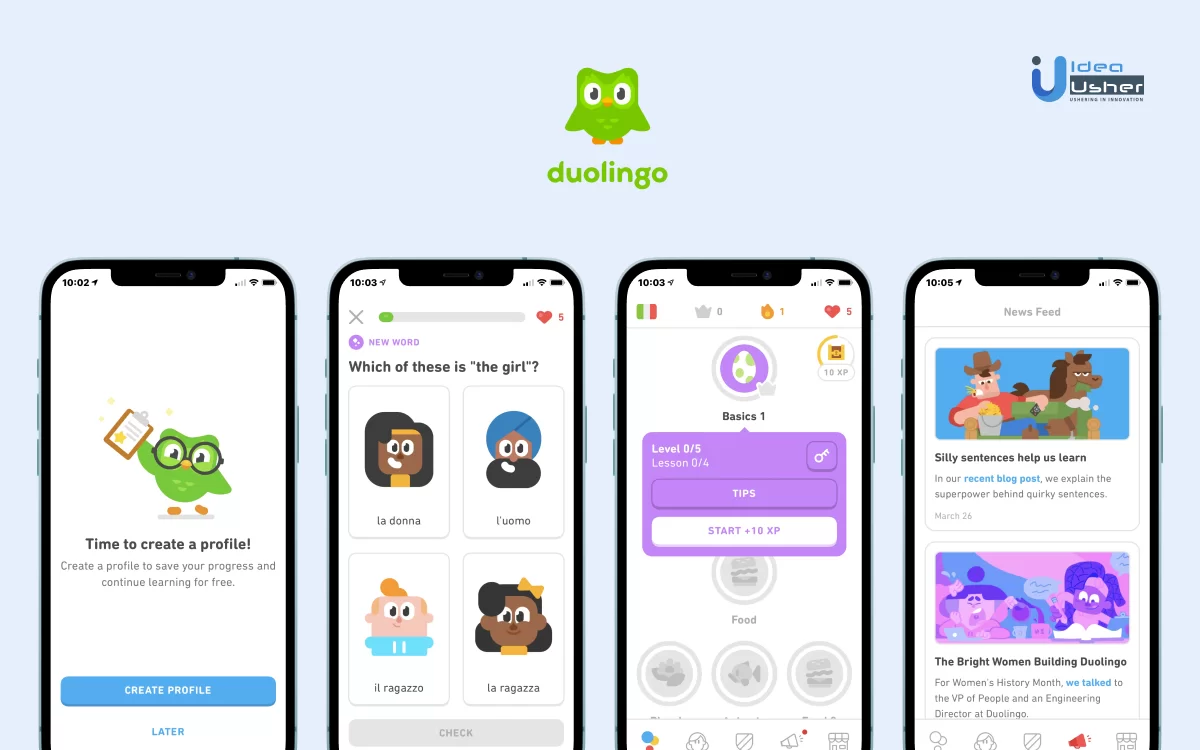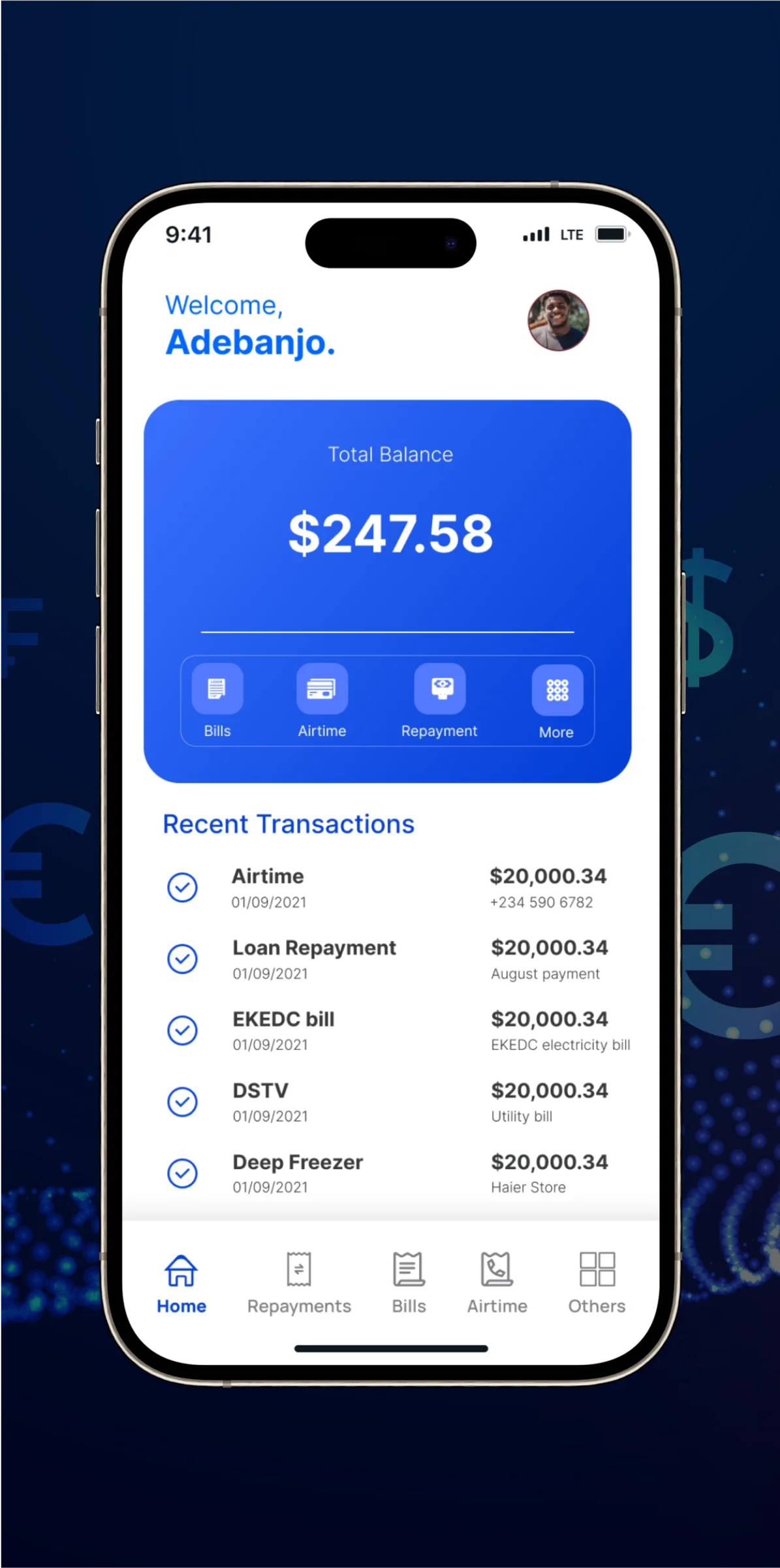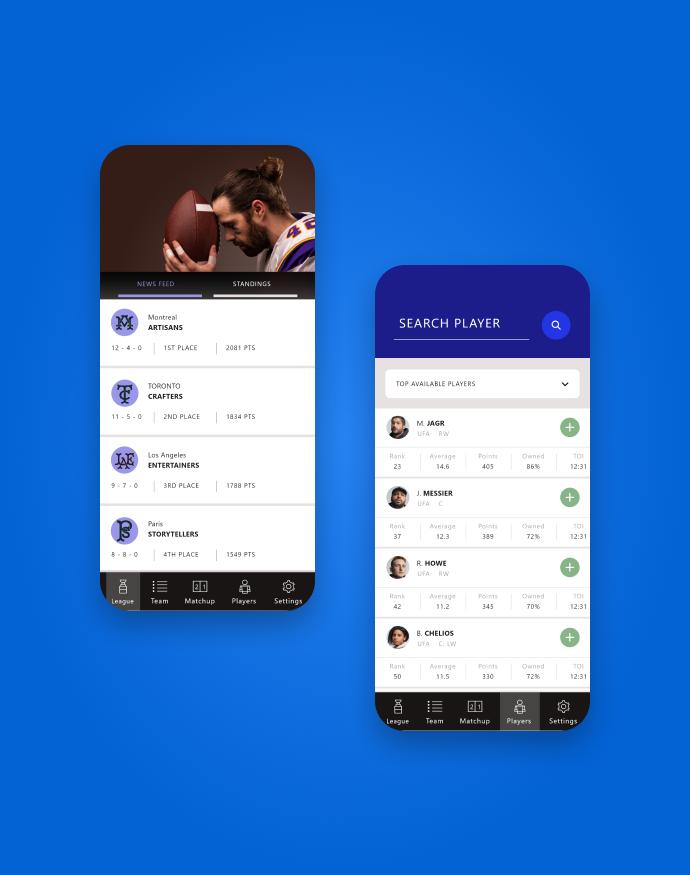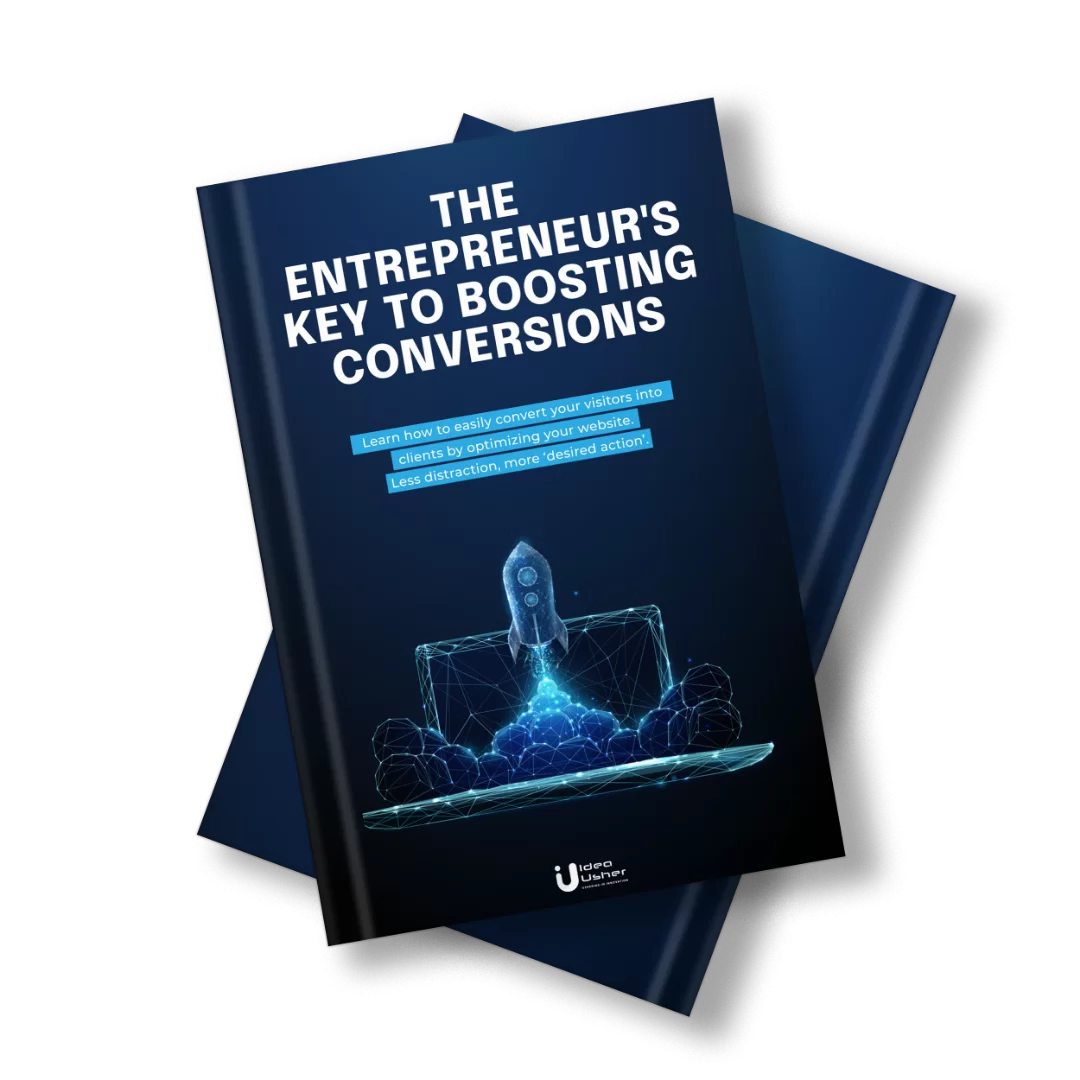- What is Duolingo?
- Duolingo features that made it famous:
- The Infrastructure of Duolingo
- How does Duolingo make money and What is Duolingo’s Business Model?
- Why do you need a language learning app?
- Who are Duolingo’s Competitors?
- Top features for an app like Duolingo
- How to Build a Language Learning App?
- Wrapping Up
- FAQs

We live in a multilingual world, where increased globalization demands you to know a second language, which eventually gives you an advantage over others.
Learning another language is becoming a usual activity amongst the youngsters and business professionals. It’s because they want to lift the language barriers and integrate with the people globally.
Moreover, companies prefer bilingual professionals, as they seek to trade and create relationships with different countries.
Learning another language is becoming easier with mobile apps. A language learning app uses AI and Machine Learning (ML) to enhance your skills.
This blog will describe everything you need to know about a language learning app and how to develop it.
- What is Duolingo?
- Duolingo features that made it famous:
- The Infrastructure of Duolingo
- How does Duolingo make money and What is Duolingo’s Business Model?
- Why do you need a language learning app?
- Who are Duolingo’s Competitors?
- Top features for an app like Duolingo
- How to Build a Language Learning App?
- Wrapping Up
- FAQs
What is Duolingo?
Duolingo is a leading language-learning mobile and web app that helps you to learn numerous languages spoken around the world. It also conducts digital language proficiency assessment exams.
It uses AI, machine learning, innovative tools, and psychology to enhance your learning. It uses pictures, sounds, games, reading, writing, and listening, making it even more interactive for the end-user.
Duolingo is a free app, though you can buy ‘Duolingo Plus’, which comes with a monthly fee of $6.99 per month.
Duolingo ranks No.1 Education App on Google Play rankings in Canada and United Kingdom and No.3 in the USA and France. It also ranks No.2 in terms of the most used Education App in Canada, Germany, the United States, and the United Kingdom.
On the App Store, Duolingo ranks No.1 on Editor’s Choice Apps and High School Apps and No. 4 on Notable Education Apps.
There are currently 100 million Duolingo downloads on Google Play Store and 99 million on App Store.
| Language application | Duolingo |
| Launch year | November 2011 |
| Founders | Severin Hacker, Luis von Ahn |
| Annual revenue | $161.7 million (by the end of the year 2020) |
| Languages offered currently | Spanish, Italian, Hindi, English, and 40+ different languages |
| Development Languages used | Swift, Kotlin, Java, Python, React, CSS, ScalaHTML |
Duolingo features that made it famous:
- Ten thousand plus words and more than 23000 sentences per language.
- Forty most popular languages like English, French, German, Hindi, Portuguese, etc.
- Skill Level Enhancement, i.e., any user can start learning whether beginner or an experienced learner.
- Skill Tree – A tree includes everything about a language, e.g., basics, grammar, phrases, etc., A user has to begin from the top of the tree, and the course runs until they reach the bottom of the tree.
- Units – Division of the tree into nine units, and these units get more complicated as the previous unit has been passed.
- Division of lesson into three tasks – translation, write what you hear, and multiple-choice fill in the blanks.
- This app also has vocab lessons, which prompt a user to match images with words.
- The notes tab makes it easier for the user to learn> It contains conjugation tables, grammar tips, common mistakes, example sentences, and other helpful notes.
- The app also has a resource library containing practice sessions, stories, podcasts, and specific events that one can follow up.
- Leaderboards make it more competitive for users, where they can compete with users around the globe.
The Infrastructure of Duolingo
Duolingo uses a suite of products from Amazon Web Services such as Amazon DynamoDB, Amazon Virtual Private Cloud, 200 virtual instances in Amazon Elastic Compute Cloud (EC2), Amazon Simple Storage Service (S3), and Amazon Relational Database Service (RDS).
Frameworks and Languages:
- Python – The backend of the app is written in the Python programming language.
- Scala – A component called ‘session generator’ was rewritten in Scala.
- The frontend was written in Backbone.js and Mustache but is now primarily written in Redux and React.
How does Duolingo make money and What is Duolingo’s Business Model?
Duolingo initially employed a crowd-sourced business model, where organizations such as Buzzfeed and CNN paid them for translations.
Duolingo is a free app, but they have periodic advertisements on their platforms.
As they grew, they switched to a freemium model for their mobile app and web app known as “Duolingo Plus” and includes:
- unlimited hearts,
- level skipping,
- progress quizzes, and
- no advertisements
Duolingo’s revenue, since they gained recognition, is as follows:
| Year | Revenue |
| 2016 | $1 Million |
| 2017 | $13 Million |
| 2018 | $36 Million |
| 2019 | $70.8 Million |
| 2020 | $161.7 Million |
According to Forbes, Duolingo derives 50% of its revenue from ads, 48% from in-app purchases, and 2% from its Duolingo English Test.
At the end of 2020, it had 1.6 million paid subscribers and more than 300 million registered users.
Why do you need a language learning app?
Learning a new language will enhance all aspects of your life. Learning a new language will make you a better person, will increase your career opportunities, and you’ll find out more about the world around you.

But are you willing to learn from an app?
Many people would prefer physical learning over learning virtually. Still, virtual learning has become a part of our lives due to the world’s current crisis, and many people believe virtual learning is the future of learning.
This is the part where a language learning app comes in, to be more precise, ‘a free app.’
You would want to learn many new skills, but there’s no time. Virtual learning saves most of your time and cost, giving you more time to learn numerous skills at once and saving your money so that you can invest at a more needed place.
Benefits of App Learning:
- Inclusivity – Many students are shy or introverts, who might get excluded during a physical learning session, but this app helps them a lot.
- Ease in Accessibility – Anyone can access the app and start learning by having an Internet connection and a Mobile phone. These apps can be accessed anytime over the internet, 24 hours a day.
- Cost Saving – An app saves your travel cost, accommodation cost, and some other expenses. Moreover, the price you pay for virtual learning is very much lower than a physical classroom.
- Expanded WorldView – Users can compete with people around the globe who are learning the same language. This competition makes it more interesting than a boring physical classroom.
- Flexibility and Comfort – You can learn whenever you want at any hour of the day; learning from home is also comfortable for all of us. This is by far the best option for students with some physical disability.
Who are Duolingo’s Competitors?
There are many apps like Duolingo, but we have chosen the four best alternatives.
1. Babbel Language Learning
It is the world’s first language learning app, made in Germany, and debuted in 2007.
Babbel uses its user interface to adapt itself to the learning ability of the user. For example, if a user learns better through listening, the app will tailor itself to that preference and teach you accordingly.
Though the App only has 14 languages, most of them are European languages.
The App is free, but users can access most of their content only through their subscription model, which costs you $6.95 per month for 12 months.
2. LingoDeer
It is another language learning app famous amongst users. It is based in China and teaches you around ten different languages.
This app provides the same experience as Duolingo, i.e., it gamifies learning.
LingoDeer provides comprehensive resources for students learning Japanese, Vietnamese, Mandarin, and Korean.
The app is completely free, and unlike other free apps, it does not have any periodic advertisements, and students can also download lessons for free.
3. Busuu
This app is developed for those who want to learn in a group.
It is wholly focused on collaborative learning.
Students can get their performance reviewed by native speakers and learners for verbal and written exercises. It contains 12 Languages which are relatively minor.
Most of the features of the app require a subscription.
The premium version of Busuu allows you to have a live conversation with native speakers and certifies you with McGraw-Hill Education.
4. Lingvist
A combination of machine learning, language statistics, and cognitive science theory.
It is based in Estonia. The app features only four languages for English speakers, French, German, Spanish, and Russian, and users can also learn Estonian.
It also teaches UK and US English to speakers of distinctive tongues. Lingvist uses AI and neural networks to enhance your learning ability. It keeps track of all your learning activities and presents you with daily goals.
Though the app features just four languages, it is deemed content-rich in every aspect, whether it’s vocabulary, grammar, or any other thing.
Like Duolingo, it also employs a freemium model, with subscriptions starting from $7.50 per month.
Top features for an app like Duolingo
1. Sign In & Manage Profile
When it comes to developing a mobile application, the registration process is a key feature that requires careful consideration. To make it easy for users to sign up, you can take inspiration from apps like Duolingo and keep the registration process simple. This can include integrating social media platforms to allow for a quick and hassle-free sign-up process.
Another important feature to consider is the ability for users to manage their profiles. This allows them to keep track of their progress and assignments, as well as save educational videos and lectures for future reference. By incorporating these features, you can create an engaging and user-friendly mobile application that will attract and retain users.
2. Select Courses
Another useful feature to consider when developing your language learning mobile application is the ability for users to register for courses based on their budget. You can either integrate this feature with the registration process or keep it separate to ensure a seamless user experience.
By offering users the ability to choose from a variety of course options that fit their budget, you can attract a wider audience and make language learning more accessible to everyone. This feature can also help users save money and time by allowing them to select courses that are best suited for their needs.
3. Online Revision Test
By enabling users to take online revision tests, they can easily check their progress and identify areas where they need improvement. This feature can help users enhance their language skills by highlighting their strengths and weaknesses and suggesting areas for improvement.
Moreover, this performance tracking feature can help users stay motivated and engaged in their language learning journey by providing them with a clear sense of their progress over time. By incorporating this feature in your mobile application, you can create a more personalized and effective language learning experience for your users.
4. Payment Options
By integrating multiple payment gateways, users can make payments using any preferred method, which can increase trust and reliability in your application.
The payment process can be a significant factor in retaining users on your app, so it’s important to make it as easy and secure as possible. By incorporating various payment options, you can offer a more flexible and convenient payment experience for your users.
5. Certification
You can collaborate with educational institutions to offer these certificates to deserving candidates, which can help establish your application’s credibility and make it more user-friendly.
By providing certificates to users, you can help them showcase their language learning skills to potential employers or other educational institutions, which can help boost their career prospects. Additionally, this feature can increase user engagement and motivation to complete courses within your application.
6. Support & Assistance
By incorporating this feature, you can provide users with quick and efficient solutions to their queries regarding services, courses, payments, and more.
Having a reliable support and assistance feature can help users feel more confident and comfortable while using your application. It also helps to create a more personalized and interactive user experience by enabling users to ask questions and receive answers in real-time.
How to Build a Language Learning App?
1. Foreseeing Your App
Envision your app so that you can distinguish your app from other apps by providing something that a user needs and does not exist in the world around you—e.g., deciding your course structure, UI, choosing your OS, etc.
2. Cost Analysis
Your language learning app needs a hosting platform, developers, advertisements, amongst many other things. Determining your costs for all these services is a crucial step before the development of your app.
3. Developing your Application
Hiring an excellent developer for your app. There are many developers in the market, but choosing the best of them is a task itself. After that, a prototype is developed so that the vision of your app is aligned with the vision of the developer.
After the developer is finished with the development, the app is tested by collecting feedback from a group of people (beta testing). The development team does this testing too (alpha testing).
4. Launching the App
Once your app has passed the tests, you are ready to launch the app in the market. However, you must seek approval from the OS companies before your app goes live.
5. Maintenance
You must attend to user feedback, monitor your scaling needs, and update your apps occasionally to make them more interactive for users.
Read more: How to do Mobile App Development Outsourcing in 2021
Wrapping Up
The demand for language learning and virtual learning is increasing day by day, and a language learning app can fulfill these demands. There are many applications available in the market, but the best of them is Duolingo.
Duolingo is an excellent application, but there are always some drawbacks, which an individual can see or feel.
We all have different perceptions, and more than 300 million people use Duolingo, which means hundreds of millions of perceptions.
The most common perception people carry is the voice used in the application. The voice is unclear because the pronunciation is very different from what we see or write, which needs more improvement.
Hence, many of us would like our variant of the app, with more distinctive features and more accessible experiences.
Are you one of these ‘many’?
If yes, then let’s get together and build an app that helps people overcome their language problems.
Feel free to get in touch with us to get your language learning app built now!
FAQs
Q. How Much Does it Cost to Build an App like Duolingo?
A. There are many app developers in the market, and their per hour rate varies depending on the vision of your app; the development cost might start from around $35 per hour to $50 per hour or even more.
An app development agency does almost everything for you, from development to marketing. Though you might choose the services you want and the services you don’t, you can cut some of the costs.
Q. How Long Does it Take to Build a Language Learning App?
A. The app development process is time-consuming. App development requires a lot of engineering, both backend, and frontend like data integration, UI design & development, etc.
Q. Does Duolingo Work?
Many People believe that Duolingo is a convenient way to learn a language. It has 300 million registered users around the world, and those numbers speak for themselves. Duolingo is easy and fun; it gamifies your learning experiences which makes it even more interactive.
You can learn phrases, grammar and develop your vocab skills with a single tap.
It teaches you according to your needs and interests. Hence, Duolingo works if you are an interactive user and willing to learn a language.








